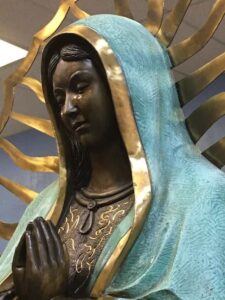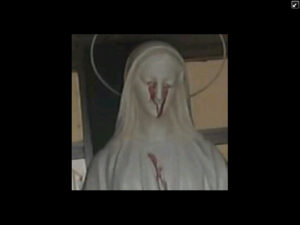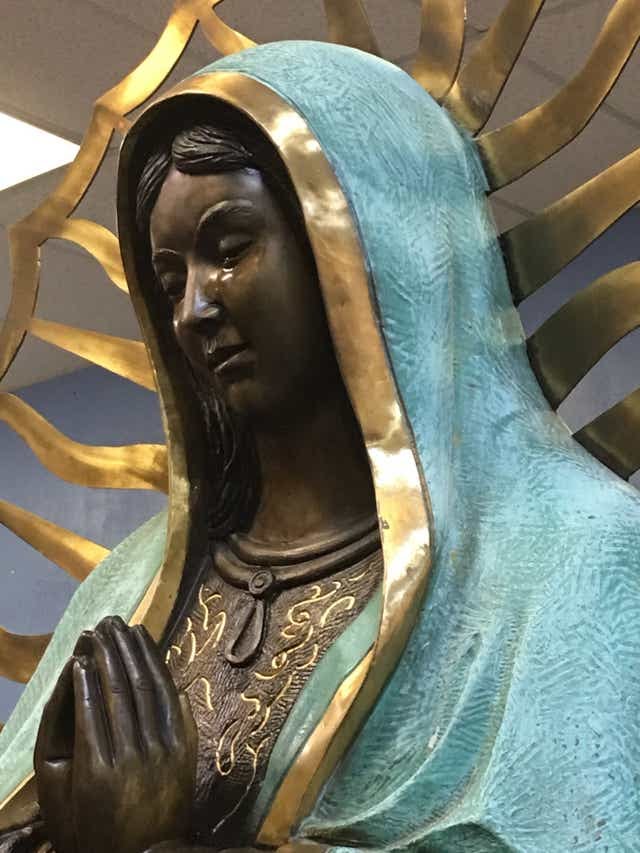A Virgin Mary statue in a New Mexico Catholic church that has appeared to be weeping in the past is reportedly crying again which has drawn crowds of religious people to witness the unusual scene. The statue had weep years back including recent 2018 and is weeping again.
The Blessed Virgin Mary, the mother of Jesus and the church is known for several apparitions and statues’ weep where repentance message is always the major message given(Repent before the hammer strike).
Visitors of the bronze statue located inside the auxiliary building of Our Lady of Guadalupe Catholic Church said that Tuesday the statue wept, like it did for several hours last Sunday, the Hobbs.

Ronquillo said the statue began crying as the group inside the church finished a Rosary.
“It’s beautiful,” she said. “The tears aren’t watery, they are an oil-like substance and the tears smell like roses.”
Fellow parishioner Laura Cisneros, who was with her family at the Sunday Mass when the statue began crying, was also present Tuesday. She says it was “amazing.”
The Blessed Virgin Mary statues have also reportedly to be weeping in Nigeria in Nsugbe, Enugu, others.
A village in Nkwo Nike, Enugu, the statue of the Blessed Virgin Mary in the grotto reportedly cried out blood after a child that She always appear to went to her and asked for proof that it is real (Her apparations), the boy fainted after.
Also, Mary’s statue breed blood at St Catherine Catholic chaplaincy under Archdiocese of Onitsha, Nwafor Orizu College of Education Nsugbe in Anambra state Nigeria in 1999.
Others include the apparitions recorded in Umunya, Minna, etc.

Overview:
A weeping statue is a statue which has been claimed to have shed tears or to be weeping by supernatural means.
Statues weeping tears which appear to be blood, oil, and scented liquids have all been reported. Other claimed phenomena are sometimes associated with weeping statues such as miraculous healing, the formation of figures in the tear lines, and the scent of roses.
These events are generally reported by Christians especially Catholics and initially attract pilgrims.
In a Catholic parish in Hobbs, New Mexico, a statue of the Virgin Mary has been “weeping.”
Onlookers have gathered out of curiosity, and also for prayer and healing. The liquid on the statue has been found to be olive oil and balsam.
Claims about supernatural phenomena, including weeping statues, have historically been common in Catholicism. A well-known example is the Madonna of Syracuse, Sicily, a plaster statue that has shed tears since 1953.
In fact, weeping statues were reported in Hungary, Argentina, Nigeria and Macedonia, just to name a few.
To understand why a weeping statue would be religiously meaningful, it’s first important to appreciate the connecting message between miracles and the Virgin Mary.
Catholics believe Mary is the mother of Jesus Christ and, therefore, the mother of God.
Throughout Catholic history, supernatural events have been attributed to Mary’s power.
When France’s Chartres cathedral burned, only Mary’s relic – called “The Veil of the Virgin”– survived after being safeguarded by three priests who were miraculously preserved from the heat and flames.
Mary’s intercession is also believed to have ensured victory at the Battle of Lepanto in 1571, when an Ottoman fleet was repulsed by the forces of Genoa, Venice and the papacy.
Mary’s tears have special significance for Catholics: She cries not only over the sins of the world, but also over the pain she endured in her earthly life, referred to as “the seven sorrows of Mary.” These sorrows, which include the crucifixion and death of Jesus, are depicted by seven swords piercing Mary’s flaming heart.
Even the flowery scent of olive oil and balsam evokes Mary since she is called “the rose without thorns.”
Any trickery report? :
Most of the times comes controversial.
The possibility of trickery is there, but most of the reports are reliable, real, miraculous with a Call for Total repentance before the hammer strike.
In examining claims of the supernatural, bishops are guided by standards set by the Vatican’s Congregation for the Doctrine of the Faith, which oversees Catholic doctrine. These standards primarily concern reports of “apparitions” of the Virgin Mary.
The bishop, or a committee appointed by him, evaluates the supernatural phenonmenon’s impact on the community. Positive aspects can be healings and conversions, or even a more general deepening of faith among Catholics.
Negative aspects would include sinful acts such as selling oil from a weeping statue or making claims contrary to Catholic doctrine.
One of the primary questions is whether the event has been staged. For example, in two cases of statues that wept blood – one in Canada in 1986 and another in Italy in 2006 – the blood turned out be that of the statue’s owner.
Also, Liquids can be injected into the porous material of statues and later seep out as “tears.” Oil that is mixed with fat can be applied to a statue’s eyes, which will “weep” when ambient temperatures rise in the chapel.
But in all these few cases, Blessed Virgin Mary apparitions and statue weeping have been proven real by scientists to be real blood/oil and when carried DNA tests on it reveals trace of Israelites DNA where Blessed Virgin Mary comes from.
In the case of the bronze statue of Mary in Hobbs, New Mexico, the investigation has uncovered no such trickery. But the fact that no cause has yet been found does not mean that a miracle has taken place.
The Catholic Church rarely endorses weeping statues and similar phenomena. Usually, a bishop or the Vatican will only go as far as dating that faith and devotion are more important than tales of supernatural happenings.
Dez Mayorz report.
See more videos below.
